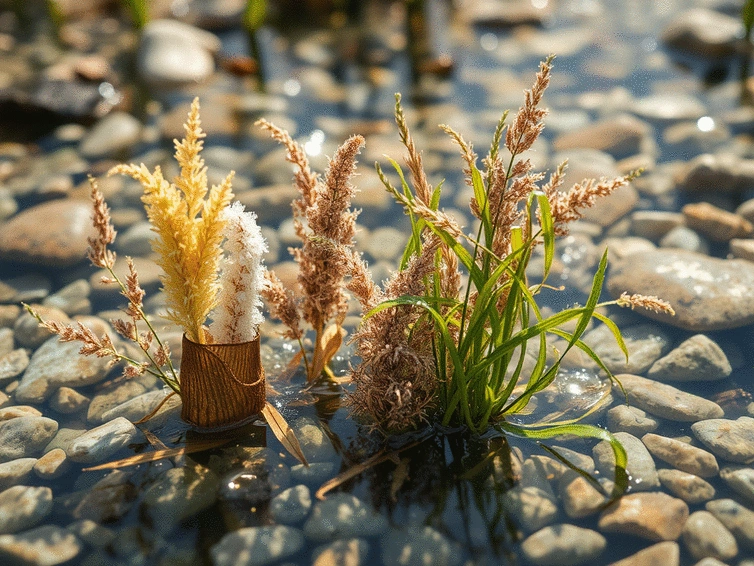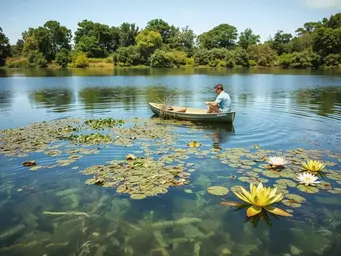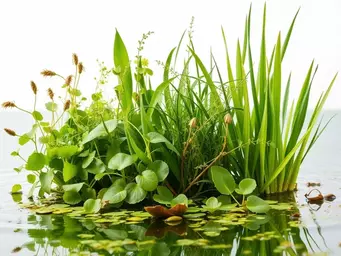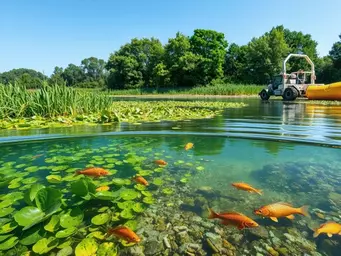
Identifying Aquatic Weeds Made Easy
Curious about the unseen champions of our waterways? Aquatic weeds, often overlooked, are vital for ecological balance, providing oxygen and habitat for diverse aquatic life. Let's explore their significance and learn how to manage these essential plants effectively.
What You Will Learn
- Aquatic weeds contribute to oxygen production and water quality maintenance in aquatic ecosystems.
- Recognizing signs of overgrowth and the presence of invasive species is crucial for effective management.
- Adopting appropriate management techniques, such as mechanical removal or biological control, can restore ecological balance.
- Community involvement enhances management efforts through local initiatives and citizen science projects.
Key Roles and Management Techniques for Aquatic Weeds
Aquatic weeds play vital roles in ecosystems but sometimes require management. Below are their key contributions and effective management approaches.
Ecosystem Role: Vital Contributions
- Habitat: Shelter and breeding grounds for aquatic organisms.
- Water Quality: Regulate chemistry by absorbing nutrients.
- Oxygen Production: Crucial for aquatic life through photosynthesis.
Management Techniques: Effective Strategies
- Mechanical Removal: Ideal for smaller infestations, hands-on.
- Herbicides: Quick results when used safely, consider environmental impact.
- Biological Control: Natural predators for sustainable balance.
Understanding Aquatic Weeds and Their Importance
Have you ever wondered about the role of aquatic weeds in our precious ecosystems? These plants, while often seen as nuisances, actually hold significant importance in maintaining ecological balance in our waterways. Through photosynthesis, they produce oxygen and provide habitat for various aquatic organisms. Moreover, they play a critical role in nutrient cycling, helping to filter water and stabilize sediments. Yet, the delicate balance they contribute to can be easily disrupted by invasive species.

At Aquatic Weed Solutions, I believe that understanding the multifaceted roles of aquatic weeds is essential for effective management. By recognizing their value, we can better appreciate the need for thoughtful control measures and preservation strategies that foster healthier aquatic environments.
The Role of Aquatic Weeds in Ecosystems
Aquatic weeds serve as vital components of their ecosystems. They offer food and shelter for fish, invertebrates, and other wildlife. Without them, many species would struggle to survive. Here are some key roles aquatic weeds play:
- Habitat: They provide shelter and breeding grounds for various aquatic organisms.
- Water Quality: By absorbing nutrients, they help regulate the water's chemistry and clarity.
- Oxygen Production: Through photosynthesis, aquatic plants release oxygen, crucial for the survival of aquatic life.
As we delve deeper into the aquatic ecosystems, it becomes crucial to recognize how these plants influence everything from fish populations to water clarity. Understanding their role helps us appreciate the need for responsible management practices. For further information on the importance of aquatic plants and their role in water quality, you can refer to resources from the USDA on aquatic weeds.
Identifying the Need for Aquatic Weed Management
It's important to identify when aquatic weeds require management intervention. In many cases, unchecked growth can lead to various ecological issues, such as decreased biodiversity and impaired water quality. Signs that indicate the need for management include:
- Overgrowth: Excessive plant growth that disrupts recreational activities.
- Invasive Species: The presence of non-native plants that outcompete local flora.
- Water Quality Issues: Algal blooms often triggered by nutrient overloads from decaying weeds.
Effective management begins with observation. By staying vigilant and recognizing these signs, we can take proactive steps to restore balance to our aquatic habitats. Each action contributes to the overall health and sustainability of our waterways! You can find more insights into identifying and managing problematic aquatic weeds in publications like NMSU's guide on aquatic weed management.
We Want to Hear From You!
As we delve deeper into the complexities of aquatic weed management, we’d love to hear your thoughts! What challenges have you faced in managing aquatic weeds? Share your experiences and insights below:
Summary of Key Insights on Aquatic Weed Management
As we reflect on the insights shared about aquatic weed management, it’s clear that accurate identification is crucial. Understanding the different types of aquatic plants can significantly impact management strategies. If we can't identify these species correctly, we risk applying the wrong methods, which could lead to further ecological imbalance!
- Accurate identification helps in selecting appropriate management techniques.
- Awareness of local invasive species encourages proactive measures.
- Knowledge supports community involvement and sustainability efforts.

In my experience with Aquatic Weed Solutions, I’ve seen first-hand how effective management begins with understanding what we're dealing with. This foundational knowledge not only helps in addressing current issues but also sets the stage for future conservation efforts.
Recap of Effective Management Techniques
Throughout this article, we’ve explored various management techniques tailored to aquatic weeds. From mechanical removal to biological control methods, each approach offers unique benefits and challenges. If you find yourself facing an aquatic weed problem, consider these strategies:
- Mechanical Removal: Ideal for smaller infestations, this hands-on approach can be effective and satisfying!
- Herbicides: When used safely, they can provide quick results, but always consider environmental impacts.
- Biological Control: Utilizing natural predators can help maintain balance without introducing harmful chemicals.
Remember, the right technique largely depends on your specific situation. I always advise landowners and managers to assess their unique conditions before implementing any strategy. Knowledge is power, and being well-informed can yield successful results. For a broader perspective on the latest developments and techniques in aquatic plant management, the Aquatic Plant Management Society offers valuable resources.
Frequently Asked Questions About Aquatic Weeds
- Q: Why are aquatic weeds important for ecosystems?
- A: Aquatic weeds are vital for ecological balance. They produce oxygen through photosynthesis, provide habitat and breeding grounds for aquatic organisms, and help regulate water chemistry by absorbing nutrients.
- Q: How can I tell if aquatic weeds need management?
- A: Signs indicating the need for management include excessive overgrowth that disrupts activities, the presence of non-native invasive species, and water quality issues such as algal blooms caused by decaying weeds.
- Q: What are some effective techniques for managing aquatic weeds?
- A: Effective techniques include mechanical removal for smaller infestations, the careful use of herbicides for quick results while considering environmental impacts, and biological control using natural predators for sustainable balance.
- Q: How can local communities get involved in aquatic weed management?
- A: Community involvement is crucial. This can include organizing local workshops, establishing community groups for removal projects, and promoting native plant restoration efforts. Citizen science also plays a key role in data collection and monitoring.
- Q: What is citizen science, and how does it help aquatic research?
- A: Citizen science involves engaging local communities in research by encouraging them to report sightings of specific aquatic plants or assist in field research. This collaborative approach gathers valuable data, enriches scientific knowledge, and fosters a sense of ownership among participants.
Engagement and Community Involvement in Aquatic Weed Solutions
Encouraging Local Action for Sustainable Practices
Community involvement is vital for effective aquatic weed management. It’s inspiring to see how local initiatives can lead to significant changes in waterway health. By encouraging local action, we strengthen our collective ability to combat aquatic weeds and promote sustainable practices!
- Organize local workshops focused on aquatic weed identification and management.
- Establish community groups that collaborate on removal projects.
- Promote native plant restoration efforts to improve ecosystem resilience.
As an ecologist, I believe every person can contribute to these efforts. Whether you’re a landowner or simply a concerned community member, your involvement can make a real difference in preserving our aquatic ecosystems.
How Citizen Science Can Enhance Aquatic Research
Citizen science plays a crucial role in advancing our understanding of aquatic ecosystems. By engaging local communities in research, we can gather valuable data that informs management strategies. This collaborative approach not only enriches scientific knowledge but also fosters a sense of ownership among participants!
- Encourage community members to report sightings of specific aquatic plants.
- Utilize mobile apps for easier data collection and identification.
- Create opportunities for local volunteers to assist in field research.
Ultimately, the more we involve the community in scientific efforts, the more robust our data and management strategies will become. At Aquatic Weed Solutions, we’re passionate about blending education with action and hope you'll join us in this vital mission.
Recap of Key Points
Here is a quick recap of the important points discussed in the article:
- Aquatic weeds play a vital role in maintaining ecological balance by producing oxygen, providing habitat, and regulating water quality.
- Monitoring growth is crucial; signs like overgrowth and the presence of invasive species indicate the need for management.
- Effective management techniques include mechanical removal, safe use of herbicides, and biological control methods using natural predators.
- Community involvement is essential for sustainable practices, such as organizing workshops and collaborative removal projects.
- Citizen science enhances aquatic research by engaging local communities in data collection and monitoring efforts.





Managing Aquatic Weeds Effectively
Impact of Aquatic Weeds on Recreation
Understanding Aquatic Weed Varieties
Integrated Aquatic Weed Management Methods
Integrated Approaches to Aquatic Weeds